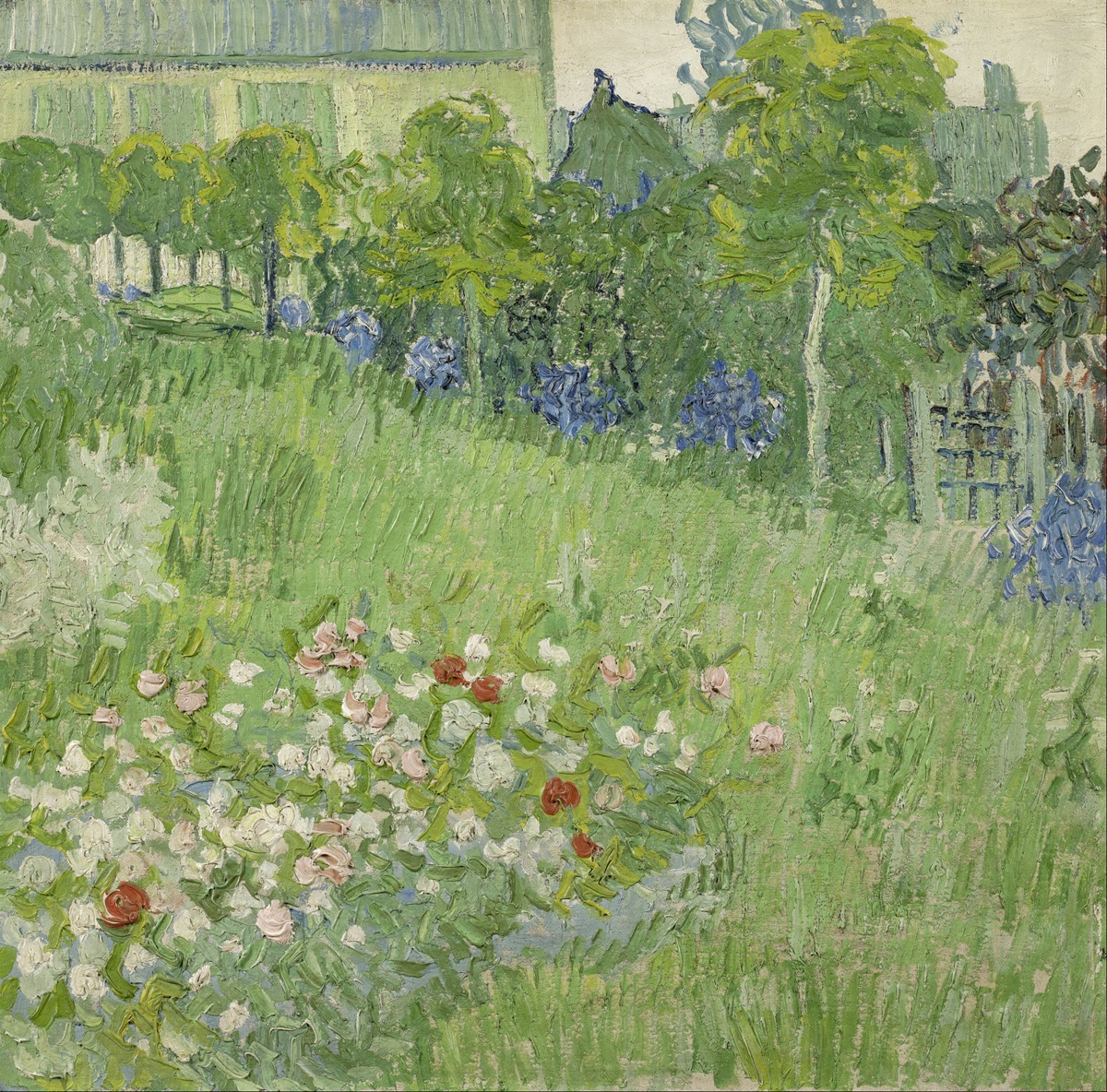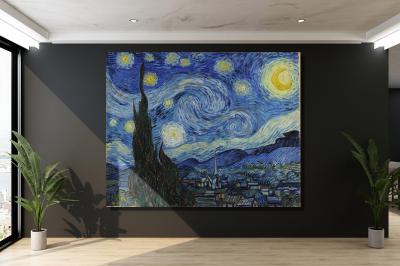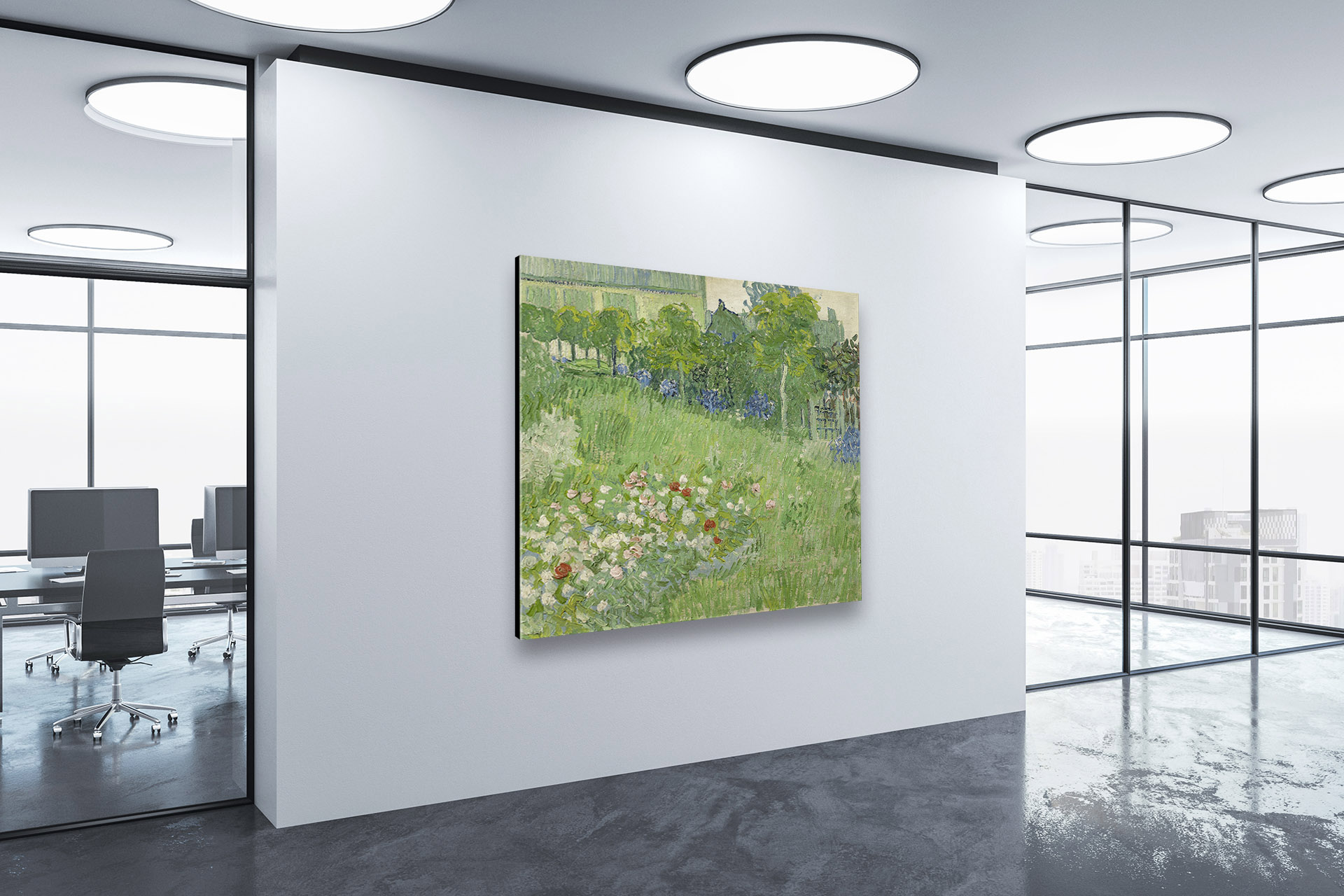Daubigneys Garden
By Vincent van Gogh, 1890
Daubigny’s Garden: Vincent van Gogh’s Luminous Tribute to Nature
Vincent van Gogh, a name synonymous with artistic brilliance and emotional intensity, left behind a legacy of paintings that continue to captivate the world. Among his many masterpieces, “Daubigny’s Garden” stands as a testament to his profound connection with nature and his ability to infuse ordinary scenes with extraordinary vitality. In this extensive exploration, we embark on a captivating journey into the heart of van Gogh’s “Daubigny’s Garden,” unraveling its layers of meaning, emotions, technical challenges, the significance of its location, and delving into the remarkable life of the painter himself.
The Garden of Inspiration
Vincent van Gogh’s serendipitous encounter with fellow artist Charles-François Daubigny marked a pivotal moment in his artistic odyssey. It was Daubigny’s enchanting garden, nestled in the idyllic landscape of Auvers-sur-Oise, France, that would become a wellspring of boundless inspiration for van Gogh during his final years. This quaint garden, with its lush greenery and vibrant colors, not only nurtured the plants it housed but also served as a fertile ground for van Gogh’s artistic imagination.
“Daubigneys Garden” Large Canvas Prints from WhiteClouds
A Symphony of Colors
Upon beholding “Daubigny’s Garden,” one is immediately struck by the profusion of colors that van Gogh employs with extraordinary finesse. The painting radiates with a kaleidoscope of hues, from the brilliant blues of the sky to the verdant greens of the foliage. Van Gogh’s technique is a visual crescendo that envelopes the viewer in a swirling symphony of vibrant tones. The use of thick, textured brushstrokes and the bold application of pigments impart the scene with an undeniable vitality, almost as if the canvas itself were teeming with life. The sunlit garden, captured with a dazzling array of colors, feels like a living entity, inviting us to step into its enchanting world.
The Power of Perspective
A hallmark of van Gogh’s genius in “Daubigny’s Garden” is his innovative manipulation of perspective. Placing the viewer at the very heart of the garden, he grants us a privileged position to intimately engage with the scene. The choice of a low vantage point is deliberate, drawing the eye into the lush undergrowth, accentuating the importance of the foreground, and conjuring a profound sense of depth and immersion. With this masterful technique, van Gogh transports us into the heart of the garden, inviting us to explore its beauty as if we were physically present.
The Dance of Light
Among the most captivating elements of “Daubigny’s Garden” is van Gogh’s portrayal of light. His keen observation and skillful rendering of sunlight filtering through the leaves choreograph a mesmerizing dance of shadows and highlights. The radiant sunburst in the sky, rendered with passionate brushwork, bathes the entire scene in a warm, golden glow, infusing the garden with an otherworldly serenity and tranquility. Van Gogh’s extraordinary ability to capture the ephemeral qualities of light elevates this painting to the realm of the sublime. Through his deft handling of light, the artist encapsulates not just a moment but an entire atmosphere, imbuing the garden with an ethereal, almost spiritual, quality.
Technical Challenges
Creating “Daubigny’s Garden” presented van Gogh with numerous technical challenges. The artist’s reliance on thick impasto brushwork, characterized by the heavy application of paint, posed a unique set of difficulties. The impasto technique not only required him to use substantial amounts of paint but also demanded a careful balance to avoid overloading the canvas. Achieving the right texture and depth in each brushstroke was a laborious process that demanded exceptional skill and patience.
The Location and Its Significance
The location of “Daubigny’s Garden” adds another layer of significance to this masterpiece. Auvers-sur-Oise, where Daubigny’s garden was situated, was a picturesque village on the outskirts of Paris, and it held a special place in the hearts of many artists of the time. It was here that van Gogh found solace in the rural beauty, seeking refuge from the tumultuous struggles of his life. The garden’s serene setting allowed van Gogh to connect with the essence of nature and capture its vibrancy on canvas. The choice of this location speaks to the importance of place in art, as it not only influenced the subject matter but also provided the artist with the tranquility necessary to create such a masterpiece.
Emotion in Every Brushstroke
Beyond its visual splendor, “Daubigny’s Garden” is a canvas that exudes profound emotional resonance. Vincent van Gogh’s tumultuous inner world found solace and expression through his art, and this masterpiece is a poignant testament to that connection. The brushstrokes, both intense and swirling, the palette, both vibrant and evocative, reveal the artist’s inner turmoil and his ardent desire to convey the beauty and vitality he perceived in the world. Every mark on the canvas appears to be a manifestation of his deepest emotions, as if he had poured his very soul onto the painting, creating a work that resonates with viewers on a deeply personal and emotional level.
The Life of Vincent van Gogh
Vincent van Gogh’s life was a testament to his unrelenting passion for art. Born in 1853 in the Netherlands, he embarked on his artistic journey at a relatively late age, finding his true calling as a painter in his twenties. His artistic career was characterized by periods of immense creativity, often fueled by his profound connection to nature and the human condition.
Van Gogh’s life was marked by both artistic triumphs and personal struggles. His relentless pursuit of artistic excellence often led him to confront emotional and psychological challenges. His friendship with fellow artists like Paul Gauguin and the influence of Japanese art left an indelible mark on his work, contributing to the distinctive style that defines his oeuvre.
The artist’s emotional turbulence, coupled with his passion for capturing the essence of life on canvas, ultimately culminated in a tragically short life. Van Gogh’s death by suicide in 1890, at the age of 37, marked the end of his tumultuous journey, but it also solidified his place in the annals of art history as one of the most influential and iconic painters of all time.
 Daubigneys Garden by Vincent van Gogh
Daubigneys Garden by Vincent van Gogh
Conclusion
Vincent van Gogh’s “Daubigny’s Garden” is not merely a painting; it is a profound and transcendent experience. It stands as a luminous tribute to his extraordinary talent, the technical challenges he overcame, and his boundless love for the natural world. Through a symphony of colors, innovative perspective, and the masterful portrayal of light, van Gogh invites us into a garden that is both a physical place and a metaphorical space for emotional expression.
As we stand before this mesmerizing masterpiece, we can almost feel the artist’s passion and anguish, his joy and sorrow, all woven into the tapestry of the garden. “Daubigny’s Garden” is an enduring testament to the enduring power of Vincent van Gogh’s artistry, a work that continues to inspire and move us, inviting us to explore not only the beauty of the garden but the depths of our own souls, while also appreciating the technical challenges he overcame and the significance of its location in his artistic journey. With every stroke, van Gogh’s emotional intensity pours onto the canvas, and as we immerse ourselves in “Daubigny’s Garden,” we become witnesses to his turbulent yet profound connection with the natural world. This masterpiece transcends time, resonating across generations, and remains an eternal muse, reminding us of the enduring legacy of a tormented genius and his ability to turn a simple garden into a portal to the human soul.
Frequently Asked Questions About “Daubigny’s Garden”
- Where is “Daubigny’s Garden” currently located? The painting “Daubigny’s Garden” is part of the collection at the Van Gogh Museum in Amsterdam, Netherlands.
- What is the size of the painting “Daubigny’s Garden”? The dimensions of “Daubigny’s Garden” are approximately 73 cm × 92 cm (28.7 in × 36.2 in).
- When was “Daubigny’s Garden” painted? Vincent van Gogh created “Daubigny’s Garden” in 1890.
- What was the inspiration behind this painting? The inspiration for “Daubigny’s Garden” was Charles-François Daubigny’s garden in Auvers-sur-Oise, France, which van Gogh found captivating during his time there.
- What technique did van Gogh use to create the textured brushwork in “Daubigny’s Garden”? Van Gogh used an impasto technique, applying thick and textured brushstrokes to create the distinctive texture and depth in the painting.
- What is the location depicted in “Daubigny’s Garden”? “Daubigny’s Garden” depicts the garden of fellow artist Charles-François Daubigny in Auvers-sur-Oise, France.
- Can you explain the symbolism behind the colors used in the painting? While van Gogh didn’t explicitly discuss the symbolism, the vibrant colors represent the vitality and beauty of nature.
- What was the emotional state of Vincent van Gogh when he painted “Daubigny’s Garden”? Van Gogh’s emotional state during this period was characterized by both moments of joy and moments of inner turmoil. The painting captures a sense of emotional intensity.
- Are there any notable exhibitions or events related to “Daubigny’s Garden”? “Daubigny’s Garden” has been featured in various exhibitions and retrospectives dedicated to Vincent van Gogh’s works.
- What is the significance of “Daubigny’s Garden” in Vincent van Gogh’s body of work? “Daubigny’s Garden” is significant as it reflects van Gogh’s deep connection to nature and his unique style of capturing light and emotion in his art.
- Can you provide insights into the history of the painting, including its ownership and provenance? “Daubigny’s Garden” has a documented ownership history and is part of the Van Gogh Museum’s collection.
- Are there any notable quotes or writings by Vincent van Gogh about “Daubigny’s Garden”? While there may not be specific quotes about this painting, van Gogh’s letters and writings often discuss his artistic process and his love for nature.
- How has “Daubigny’s Garden” influenced other artists or art movements? Van Gogh’s unique style and approach to capturing nature have influenced numerous artists and contributed to the development of modern art.
- Can I purchase a print or reproduction of “Daubigny’s Garden”? Yes, you can purchase prints and reproductions of “Daubigny’s Garden” from various sources. Here is WhiteClouds purchase link: “Daubigneys Garden” Large Canvas Print
- Are there any lesser-known details or anecdotes about the creation of “Daubigny’s Garden”? While there are no specific lesser-known details, the painting’s creation was during a pivotal period in van Gogh’s life, marked by both creative fervor and personal challenges.
Other Articles on Vincent van Gogh Paintings
At Eternities Gate by Vincent Van Gogh, 1890
Blossoming Almond Tree by Vincent Van Gogh, 1890
Cafe Terrace at Night by Vincent Van Gogh, 1888
Daubigneys Garden by Vincent Van Gogh, 1890
Green Wheat Field with Cypress by Vincent Van Gogh, 1889
Houses at Auvers by Vincent Van Gogh, 1890
Irises by Vincent Van Gogh, 1889
Night Café by Vincent Van Gogh, 1888
Portrait of Dr. Gachet by Vincent Van Gogh, 1890
Red Vineyards by Vincent Van Gogh, 1888
Road with Cypress and Star by Vincent Van Gogh, 1890
Starry Night by Vincent Van Gogh, 1889
Starry Night over the Rhone by Vincent Van Gogh, 1888
Sunflowers by Vincent Van Gogh, 1887
The Bedroom by Vincent Van Gogh, 1888
The Church at Aurers by Vincent Van Gogh, 1890
The Garden of the Asylum by Vincent Van Gogh, 1889
The Mulberry Tree by Vincent Van Gogh, 1889
The Potato Eaters by Vincent Van Gogh, 1885
The Yellow House by Vincent Van Gogh, 1888
Tree Roots by Vincent Van Gogh, 1890
Van Gogh Self Portrait by Vincent Van Gogh, 1887
Vase with Red Poppies by Vincent Van Gogh, 1886
View of Arles by Vincent Van Gogh, 1889
Wheat Field with Crows by Vincent Van Gogh, 1890
Wheat Field with Cypresses by Vincent Van Gogh, 1889
More WhiteClouds Videos
Contact us today to learn more about our 3D services and how we can help you achieve your goals.

